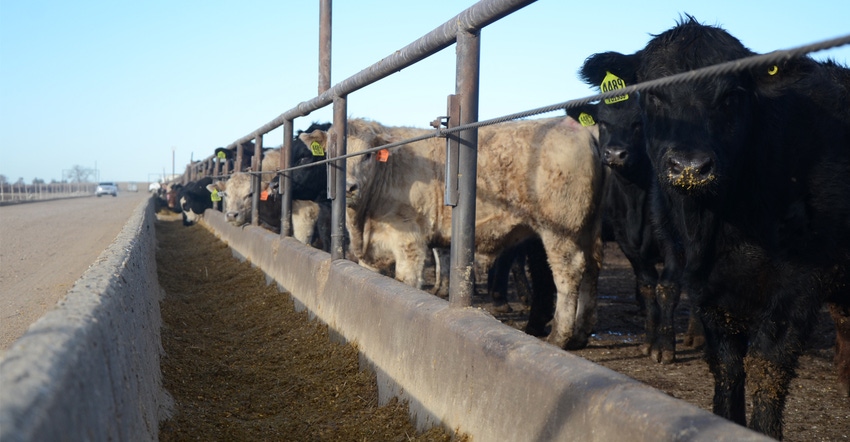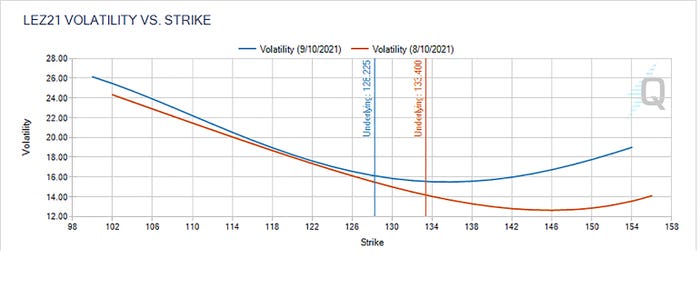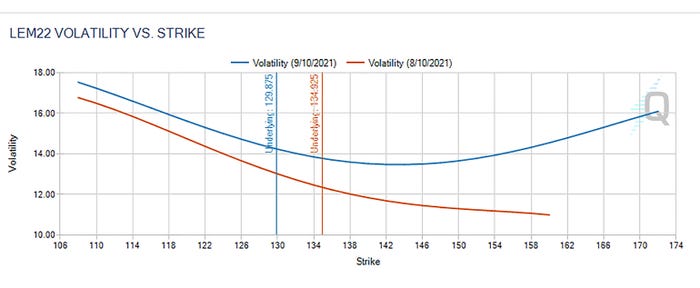September 20, 2021

Cattle producers must choose a time and a price to sell. Futures and options markets offer producers pricing opportunities every day. A few forward-pricing tools producers can use are selling futures contracts, buying put options and forward contracting.
Pertinent questions when evaluating a pricing opportunity include: Is the price acceptable? Is the price likely to move higher or lower? If the price moves, how far and how fast might it move? Can your business withstand a big, possibly abrupt, price move lower? In short — can you survive a volatile market?
Producers can use a combination of the various pricing mechanisms. For example, a pricing strategy may consist of a portfolio where some production is forward-contracted, some hedged with futures, some protected with options or a price-risk insurance product like Livestock Risk Protection (LRP), and some “unprotected” and sold at the prevailing cash market price.
Understand the probability distribution
The goal of pricing strategies is to improve odds for a favorable outcome, reduce odds for a bad outcome — and ideally, both. Producers face a range of possible prices with various odds of each occurring, which is a price probability distribution. The various pricing mechanisms can change the shape of the price distribution. In varying degrees, different pricing tools can cut off part of the downside price risk (for sellers) but may simultaneously cut off some upside potential. Producers can choose pricing tools that allow them to adjust the amount of risk they face.
The futures market eliminates the benefit of prices moving higher, but locks in an expected price, subject to basis risk. Basis risk is substantially lower than price risk. Forward contracts and options change the price probability distribution. Forward-contracting with a packer locks in the price and makes the probability of that price occurring equal to one. But this price certainty is not free. Packers typically bid less than the consensus forecast for accepting the risk that the price could go lower. Packers can cover their forward cash-contract price risk by hedging the cattle in the futures market.
Put options have a very different effect on the price probability distribution. Buying puts truncates the lower tail and shifts the probability to higher prices. The exact effect of a put option depends on the market. Recognize that as implied volatility rises — which is currently the case — option premiums become more expensive.
Implied volatility measures risk
Implied volatility is the market’s forecast of likely future fluctuations in a commodity’s price. Analysts often think of volatility as a proxy of market risk. The implied volatility cannot be directly analyzed. Instead, it functions as part of a formula used to predict the price move of an underlying asset. Our underlying asset of interest here is live cattle futures.
The futures market forecasts a point estimate for price. Options on futures, in essence, allow participants to bid on insurance rates given the amount of risk they see in the market. For example, suppose December 2021 live cattle futures are trading at $128.225. The premium to buy a put option at $123 (strike price out of the money) is $2.075. That $2.075 premium is the market’s consensus opinion as to what it would cost to insure the put option buyer that he or she will receive no less than the $123 strike price on the put option.
Understanding volatility skew
A concept in option pricing is volatility skew. It’s a bit complicated. Essentially, different strike prices on puts and calls, even on the same underlying futures and expiration date, can trade at different implied volatility levels. This can be relative to different strike prices within puts or calls or the relative value of puts versus calls. The shape of the volatility curve differs based on the perceived likelihood of outsized moves in the price of the underlying futures contract. This is helpful in understanding the most likely, optimistic, and pessimistic price forecast.
A common skew pattern is the reverse skew, or volatility “smirk.” That is, the implied volatility is higher on options with lower strike prices. It often occurs for live cattle. The popular explanation why the reverse volatility skew occurs is that market participants fear big market crashes and buy puts for protection. In some respects, fearing downside risk is not too surprising. Slaughter capacity issues, for example, have arisen in the not-so-distant past, are always possible for several reasons and have shown the potential to send prices sharply lower.
 December 2021, live cattle volatility vs. strike price
December 2021, live cattle volatility vs. strike price
(Source: CME Group, bit.ly/cmequikvoltool)

 June 2022, live cattle volatility vs. strike price (Source: CME Group, bit.ly/cmequikvoltool)
June 2022, live cattle volatility vs. strike price (Source: CME Group, bit.ly/cmequikvoltool)

The volatility skew is represented graphically by plotting implied volatilities against strike prices. The CME Group has the QuikVol Tool from QuikStrike that lets you chart and analyze volatility data. The accompanying charts show the volatility skew for December 2021 and June 2022 live cattle. They compare the skews on Sept. 10, 2021, with one month prior.
Skew shifts give insight into market direction
The curve changes, shifts up or down or tilts, as the underlying price moves. This change often gives insight into direction the market thinks the underlying futures price may move.
The December 2021 live cattle futures contract declined $5.175 from Aug. 10 to Sept. 10. The contract was as high as $137.400 on Aug. 24. This price movement caused a more pronounced curve. Expectations of lower prices fuels interest among sellers. Think producers. Sagging cattle futures directly impact producers’ bottom lines, so they will look to buy put options to limit downside risk. On the other, if a sharp move lower occurs, some participants may think the contract is oversold and expect it to reverse direction and rebound higher. This shows buying pressure exists for upside out of the money call options.
The volatility skew for longer term options. June 2022 live cattle, in this case, is flatter compared to shorter-term options, such as December 2021 live cattle. The volatilities of short-dated options are more sensitive to market changes as compared to volatilities of long-dated options. As such, volatility skews are larger for short-dated options. In other words, over the longer maturity, more jumps could occur, so the jumps average out in a way; whereas over the short term, a jump can make a bigger difference, and hence the risk of a jump increases demand for an option.
The change in the June 2022 volatility skew from Aug. 10 to Sept. 10 suggests that out-of-the-money calls are in much greater demand. In August and September, USDA raised its 2022 annual price forecast, from the month prior, for fed steers based on tighter expected supplies of fed cattle and firm demand. Second-quarter 2022 beef production is now forecasted to be 5% lower than second-quarter 2021 production. When traders anticipate tighter supply, they drive up demand for out-of-the-money calls.
The term volatile has an origin in chemistry. It means easily vaporized. In futures, profit can rapidly disappear into thin air if you are on the wrong side of a big market move.
Schulz is an Iowa State University extension livestock economist.
About the Author(s)
You May Also Like






